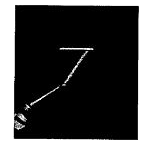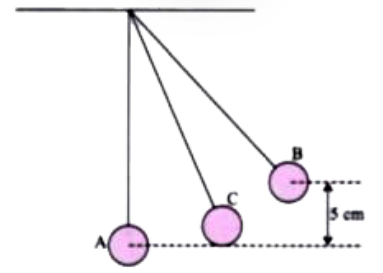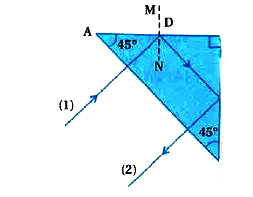With reference to the experiment shown below answer the following questions

The perpendicular shift between original incident ray produced and the emergent ray is called
lateral displacement
lateral shift
angular shift
angular deviation
The correct Answer is:A
Definition of lateral displacement
Topper's Solved these Questions
Similar Questions
The figure below shows a simple pendulum of mass 200 g. It is displaced from the mean position A to the extreme position B. The potential energy at the position A is zero. At the position B the pendulum bob is raised by 5 m.

(i) What is the potential energy of the pendulum at the position B?
(ii) What is the total mechanical energy at point C?
(iii) What is the speed of the bob at the position A when released from B ?
(Take g = 10ms−2 and there is no loss of energy.)
View SolutionThe figure below shows a simple pendulum of mass 200 g. It is displaced from the mean position A to the extreme position B. The potential energy at the position A is zero. At the position B the pendulum bob is raised by 5 m.

(i) What is the potential energy of the pendulum at the position B?
(ii) What is the total mechanical energy at point C?
(iii) What is the speed of the bob at the position A when released from B ?
(Take g = 10ms−2 and there is no loss of energy.)
View SolutionA ray of light is incident at an angle of 60∘ on the face of a prism having refracting angle 30∘. The ray emerging out of the prism makes an angle 30∘ with the incident ray. Show that the emergent ray is perpendicular to the face through which it emerges.
View SolutionThe angle between incident ray and reflected ray or refracted ray is called _____
View SolutionWhat is called the angle between the incident ray and emergent ray of a prism ?
View SolutionThe angle between the original path of the incident ray and the emergent ray coming out of a prism is called angle of
View SolutionFor right-angled prism, ray-1 is the incident ri and ray-2 is the emergent ray as shown in the figure. Refractive index of the prism is .........

View SolutionThe angle between incident ray and reflected ray or refracted ray is called _____
View SolutionA ray of light is incident at an angle of 60^@ on the face of a prism having refracting angle 30^@. The ray emerging out of the prism makes an angle 30^@ with the incident ray. Show that the emergent ray is perpendicular to the face through which it emerges.
View SolutionA ray of light is incident at 60^@ on one face of a prism which has angle 30^@ . The angle between the emergent ray and incident ray is 30^@ . The angle between the ray and the face from which it emerges is
View SolutionA ray of light incident on glass slab finally emerges out of it. The ray which emerges out is called :
View SolutionThe angle between the incident ray and emergent ray, when the ray is passing through an equilateral prism is called angle of _____.
View SolutionThe angle between the incident ray and the emergent ray in case of a prism is called angle of prism. _________
View SolutionThe perpendicular distance between the incident ray and the emergent ray in a glass slab is called the ..................... (angle of emergence/lateral displacement).
View SolutionA ray of light is incident at an angle of 60∘ on the face of a prism having refracting angle 30∘. The ray emerging out of the prism makes an angle 30∘ with the incident ray. Show that the emergent ray is perpendicular to the face through which it emerges.
View SolutionAn optical instrument is placed inside the box as shown below. The incident rays and emergent rays are also shown. The optical instrument could be _______.
View Solution
